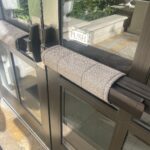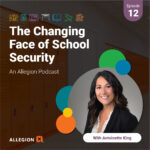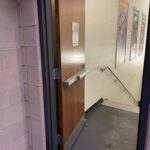
The upper door in this photo is the type of door that I’m referring to in this post about stairwell reentry. The lower door is the stair discharge door.
I’ve had a few questions about the locking of stairwell doors lately, so it’s time for a quick update. There is more in-depth information about stairwell reentry in this Decoded article, and the basics are covered in this whiteboard animation video.
Keep in mind that when I talk about locking a stair door, I am referring to the stair side of the door – not the egress side of the door leading into the stairs. Here are some frequently-asked questions…
~~~
Q: Are all stairwell doors required to unlock automatically upon fire alarm?
A: NFPA 101 – Life Safety Code allows stairs serving 4 stories or less to be mechanically locked, and includes provisions for “selected reentry” (locking some doors mechanically and allowing reentry at other doors). NFPA 101 also exempts doors in some occupancy classifications from the stairwell reentry requirements. When stair doors are unlocked electrically, NFPA 101 requires the doors to be automatically released upon activation of the building’s fire alarm system.
The International Building Code (IBC) contains different requirements for stairwell reentry; mechanical locks are not allowed on stair doors regardless of the number of stories, “selected reentry” is not allowed, and the requirements apply regardless of the use group (except maybe detention and correctional facilities). For doors that are locked on the stair side, the IBC requires the locks to be “capable of being unlocked simultaneously without unlatching upon a signal from the fire command center, if present, or a signal by emergency personnel from a single location inside the main entrance to the building.” Note: The 2024 IBC will include a change to the means of releasing the locks for reentry.
~~~
Q: The IBC includes requirements for stairs serving 4 stories or less, and for high-rise buildings. What are the requirements if I have a stair serving more than 4 stories, but the building is not a high rise?
A: I wrote about this “loophole” in the IBC in a previous blog post, and a code change proposal was submitted for the 2018 edition of the IBC to address this. The proposal (E 74-15) was approved, and the 2018 edition of the IBC will be changed to clarify the requirements. In brief, stair doors in a building that is not a high-rise will require remote unlocking as described in the answer above. For high-rise buildings, the locks are required to operate the same way, but a two-way communication system is also required. I know of several situations where the upcoming change has been used as justification for a code modification on projects currently under construction.
~~~
Q: How do I know whether to follow the requirements of NFPA 101 or the IBC?
A: This will depend on the code that has been adopted and is being enforced in a project’s jurisdiction. If both codes apply (for example the IBC as the building code and NFPA 1/101 as the fire code), typically the most stringent requirements are used, which would be the IBC requirements. Many years ago I was called by a fire marshal who was enforcing the NFPA requirements and wanted to know how he could mandate the removal of mechanical locks on a 3-story stair. The fire code he was enforcing allowed mechanical locks in that situation, so I told him to call the building inspector who was enforcing a building code that did not allow mechanical locks on stair doors. They worked together to require the locks to be removed or changed to electrified locks that could be remotely released. The only project I have worked on where selected reentry was allowed, was a federal project where the GSA chose to use the NFPA requirements even though the building code requirements were more stringent. This practice is not common.
~~~
Q. Are locks on stair doors required to be hard-wired locks which unlock upon power failure?
A. Traditionally, fail-safe hard-wired locks have been used for stairwell reentry applications, but neither of the model codes specifically require fail-safe locks, or require locks on stair doors to unlock upon loss of power (a code change proposal for the 2024 model codes may change this). If there was another way to safely and reliably unlock stair doors, the model codes do not prohibit it, but the AHJ may have some questions or may determine that the product is not acceptable. The locks would have to be capable of remote release – either from the fire alarm system or the fire command center depending on which code has been adopted.
~~~
Q. Is the stair discharge door also required to unlock remotely?
A. The stair discharge door is the door that typically swings out of the stairs and leads to the exit discharge (see photo above). NFPA 101 addresses re-entry from the stair enclosure to the interior of the building, but does not require the stair discharge door to unlock and allow access into the stairwell. The IBC specifically exempts the discharge door from the reentry requirements, stating: “Stairway discharge doors shall be openable from the egress side and shall only be locked from the opposite side.” There may be a local requirement that applies to stair discharge doors, but I have not seen one (yet).
~~~
Q. Could I use passage sets and avoid all of this confusion?
A. Yes! Passage sets are fine, as long as the building owner does not require security between the stairs and the tenant floors. In some cases where passage sets were originally installed, mechanical locks were incorrectly retrofitted later.
~~~
If you have any other questions about stairwell reentry, leave them in the reply box and I will answer them here.
You need to login or register to bookmark/favorite this content.






In my experience spec writing, it’s amazing how often fail safe locksets on paper turn into electric strikes during construction! Sometimes the A/E or AHJ notices and cares, sometimes they don’t.
What about electric strikes? Strikes can be rated, but if you use them, they must be fail secure to ensure latching. Now if power fails or the fire alarm activates the electric strike does not permit re-entry to the floor which, under the IBC would seem not to be permitted. If you “Unlock” these doors, during a fire, you make them non rated.. Thoughts? Also, if you retrofit a rated door with an electric strike, are you violating the rating by cutting into the frame? Even if the strike is rated for the application.
Hi Jim –
I would not use an electric strike on a fire door where reentry is required. I don’t know of a fail safe strike that is listed for use on a fire door assembly. In most cases, the prep for the strike in an existing fire rated frame would void the rating or require the frame to be relabeled/recertified in the field, unless the prep is approved in advance as a field modification.
– Lori
Does the stair re-entry concept depends if the door is openable after you have exited, or is it something between connecting 2 stairways?
Hi Manuel –
If the door has a passage set on it, that’s fine and you don’t have to worry about reentry. The reentry requirements address doors that are locked on the stair side under normal conditions.
– Lori
Hello Lori,
Thanks for your answer. Then, if the doors aren’t locked and there are two stairways along the building. Do I still needed to communicate the floors where the 2 stairways connect?
Hi Manuel –
I think you’re asking whether the doors between the two stairwells are required to allow someone to leave one stairwell and go to the other without encountering a locked door. The stairwell reentry sections of the codes do not address that specifically, so I believe you would need to look at the required number of exits based on the calculated occupant load and the common path of egress travel. Those requirements could mandate unlocked doors in order to allow access to both stairwells.
– Lori